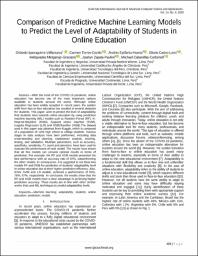“Comparison of Predictive Machine Learning Models to Predict the Level of Adaptability of Students in Online Education“

View/
Download
(application/pdf: 888.5Kb)
(application/pdf: 888.5Kb)
Date
2023Author(s)
Iparraguirre-Villanueva, Orlando
Torres-Ceclén, Carmen
Epifanía-Huerta, Andrés
Castro-Leon, Gloria
Melgarejo-Graciano, Melquiades
Zapata-Paulini, Joselyn
Cabanillas-Carbonell, Michael
Metadata
Show full item recordAbstract
“With the onset of the COVID-19 pandemic, online
education has become one of the most important options
available to students around the world. Although online
education has been widely accepted in recent years, the sudden
shift from face-to-face education has resulted in several obstacles
for students. This paper, aims to predict the level of adaptability
that students have towards online education by using predictive
machine learning (ML) models such as Random Forest (RF), KNearest-Neighbor (KNN), Support vector machine (SVM),
Logistic Regression (LR) and XGBClassifier (XGB).The dataset
used in this paper was obtained from Kaggle, which is composed
of a population of 1205 high school to college students. Various
stages in data analysis have been performed, including data
understanding and cleaning, exploratory analysis, training,
testing, and validation. Multiple parameters, such as accuracy,
specificity, sensitivity, F1 count and precision, have been used to
evaluate the performance of each model. The results have shown
that all five models can provide optimal results in terms of
prediction. For example, the RF and XGB models presented the
best performance with an accuracy rate of 92%, outperforming
the other models. In consequence, it is suggested to use these two
models RF and XGB for prediction of students' adaptability level
in online education due to their higher prediction efficiency. Also,
KNN, SVM and LR models, achieved a performance of 85%,
76%, 67%, respectively. In conclusion, the results show that the
RF and XGB models have a clear advantage in achieving higher
prediction accuracy. These results are in line with other similar
works that used ML techniques to predict adaptability levels.
“
Collections
- Web of Science (WOS) [236]

